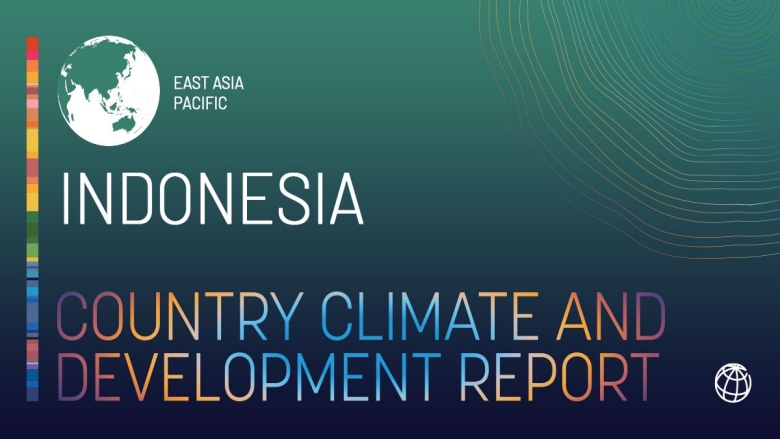Download: Full report (.pdf) Overview (.pdf) Press release

The Country Climate and Development Report (CCDR) is a new core diagnostic developed by the World Bank Group to support countries align climate actions with development ambitions. The report is developed using countries’ own stated targets, while elaborating needs and opportunities for affordably reaching those targets. The Indonesia CCDR analyzes how climate change and climate action are intertwined with the country’s growth and development.
Building on Indonesia’s ongoing climate efforts and global commitments, the report elaborates options for managing the transition to a low carbon and climate resilient economy. The report models different land, energy, and fiscal policy strategies that Indonesia could take to pursue its climate and development agenda, while investing in its people, growing its economy, and protecting its natural assets.
The Indonesia CCDR proposes a policy framework that balances climate needs with Indonesia’s development objectives to ensure that its vision to become a prosperous country can be achieved. To date, the World Bank Group has developed CCDRs for 25 countries across the globe and over time will introduce CCDRs in all countries in which it has operations.
Key Messages:
- Indonesia’s strong growth and poverty reduction over the past 20 years have moved in parallel with rising greenhouse gas emissions, consistent with its stage of development. Indonesia aims to transition to a growth model that balances environment and development, as set out in the Government’s Long-Term Strategy for Low Carbon and Climate Resilience (LTS-LCCR 2050), Low Carbon Development Indonesia (LCDI), and Enhanced Nationally Determined Contributions (NDC).
- Indonesia’s climate transition could contribute to the country’s economic growth and poverty alleviation agenda. Land, energy, and fiscal reforms in line with the NDC targets could raise Indonesia’s GDP relative to business as usual, while helping to alleviate poverty.
- Emissions are being reduced through improved land use. Indonesia aims to reach net zero emissions in Forestry and Other Land Use (FOLU) by 2030, which will make a major contribution to Indonesia’s enhanced NDC target. Land use policies implemented over the past decade are showing results, with strong decreases in deforestation now evident. Further ecosystem restoration and sustainable forest management techniques can accelerate this trend.
- The energy sector is expected to become the largest contributor to GHG emissions by 2030. As in many countries, Indonesia’s energy emissions are driven by the dominance of coal in electricity generation. The Government is working to create more space for renewable energy investments in the power system, as seen in its roadmap for early retirement of coal fired plants. In recognition of the large investment requirements, an “Energy Transition Mechanism Country Platform” is being developed as a key institutional and financing mechanism to expedite energy transition. Building on these strides, continued efforts to advance the energy transition agenda are needed, including coal phase out, strengthening the revenue model for the state-owned electricity company, retargeting of subsidies, investing in the grid network, and improving the investment climate for renewable energy.
- Low-carbon transport and efficient cities can lower emissions and deliver co-benefits. Reducing transport emissions through public transit and electric vehicles could have important development synergies, such as lower congestion and pollution reduction. A reduction in the carbon-intensity of the electricity grid will complement uptake of electric vehicles. Steps towards these goals include developing a national urban mobility policy (NUMP) framework, along with an expanded green certification mechanism to increase energy efficiency in commercial and residential buildings.
- Economy-wide actions are needed for development synergies. Going beyond actions in specific sectors (such as forestry, transport or electricity), Indonesia’s transition would benefit from further: (1) fiscal policy that includes carbon pricing and energy subsidy reform, (2) financial reform, particularly of risk management tools, (3) investment climate improvements, mainly through public-private partnership framework and state-owned enterprises reform, and (4) trade policy reform, particularly the reduction of certain non-tariff measures.
- A strong enabling environment for green investment by the private sector is critical. The financial system’s climate resilience could be strengthened through the development of a financial sector risk assessment strategy. Investment in renewables may be encouraged by a relaxation in the stringency of LCRs until demand can sustain local economies of scale. Reforms to the regulating framework for public-private partnerships (PPPs) and state-owned enterprises (SOEs) will also help.
- Enhanced data, spatial planning, and social protection systems will lessen climate impacts. Disaster risk management systems have improved over the past decade, along with the coverage and strength of Indonesia’s social protection system. Further enhancements to early-warning systems will help mitigate disaster impacts. Vulnerability will also be reduced through re-mapping of flood-prone zones with climate-sensitive hydrological predictions and strong implementation of spatial plans.